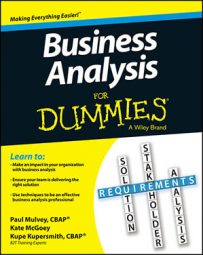After you’ve pinpointed an obstacle, identify its characteristics to get the whole picture. Is the company compelled to meet certain requirements, or are they merely suggestions? What’s the risk to the company of not complying versus changing processes or products so that it does? What exactly are the guidelines?
If stakeholders themselves are having a challenge, figure out what business-level goal, objective, or outcome they’re working to support or achieve. Do the stakeholder challenges affect the business results? What do they or the business need in order to do better or differently?
Continue your analysis by evaluating organizational support structures. Every company has organizational and operational groups that, together, do the work of the business. Each group has a role — whether formally defined or not — that is (or should be) aligned to the company’s mission, vision, and corporate strategy.
When analyzing the organization to identify business needs, you need to do three things: Identify how each group fits into the business as a whole; determine whether each group is performing its role effectively and efficiently; and diagnose whether, together, all groups are covering all the business’s needs or whether they’re suffering a gap in processes or outcome somewhere. Here are some questions to ask:
Does the role that the group is playing and the work it’s doing make sense for what it and the business are trying to achieve?
Does the group align to the bigger picture or conflict with it? Is the group missing, adding, or duplicating anything important?
Is the group collaborating and progressing work with other organizations efficiently? Is it passing any work to or getting work from other groups in a way that creates cost or inefficiencies?
Each individual group may work fine within itself, but if together the stakeholders aren’t getting the job done in a way that’s best for the business, they may have a problem.
It may not be any one stakeholder’s or group’s individual problem, but in the larger context or bigger picture of how all those stakeholder pieces fit into the overall corporate puzzle, you may identify an undelivered outcome, missing process, or a broken service line.
Conversely, you may find a group responsible for something that the company doesn’t need. Sometimes organizations or stakeholder groups evolve over time, but they keep doing tasks they’ve always done just because they’re on autopilot or don’t realize how new processes may help or hamper others.
You may have a unique opportunity to look across groups end-to-end and see them in a more holistic, business delivery light than stakeholders would be able to see themselves. Defining an organizational structure or business architecture issue that needs to be addressed can be a valuable outcome for the business and is a real achievement for you as a business analyst.
Figuring out that something important is missing from (or unnecessarily added to) the business can be a tiny operational detail or a strategic organizational concern. Depending on the specifics, it may be a nonissue to fix, but it may require executive-level discussions on workforce staffing levels, group charters, or leadership roles — potentially a political hot potato.
If what you find has senior-level impact, the way you share your findings may require some finesse. If you think you may have identified a sticky situation, seek some guidance from a mentor who can advise you on the appropriate communications approach and next steps. Do some stakeholder analysis and keep your business-savvy wits about you.

